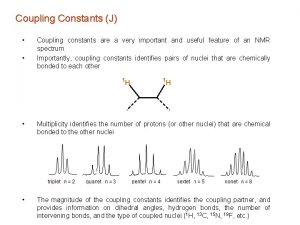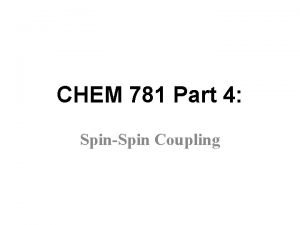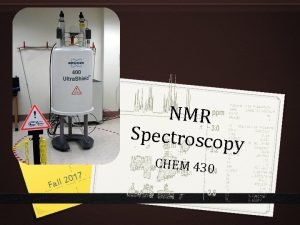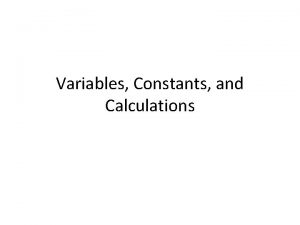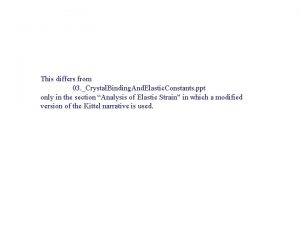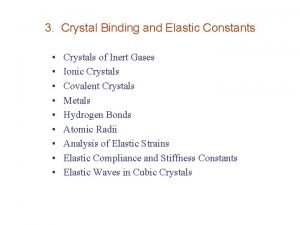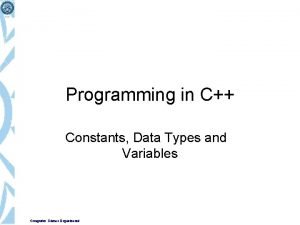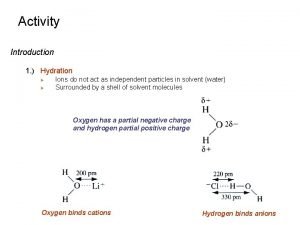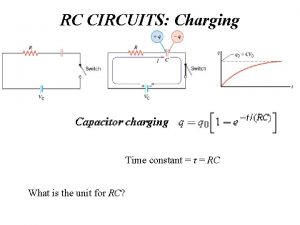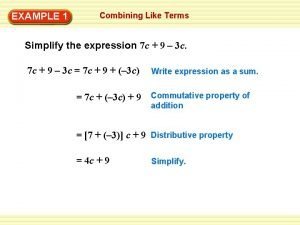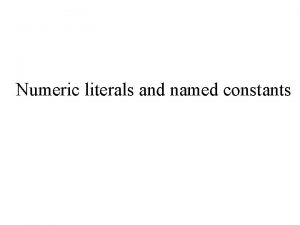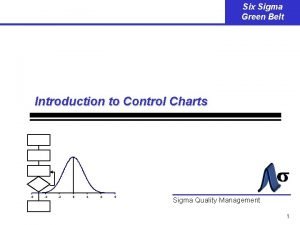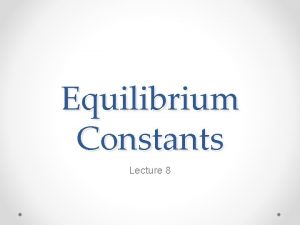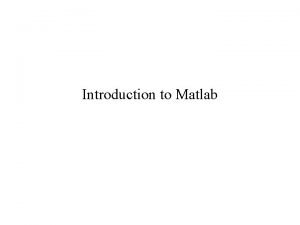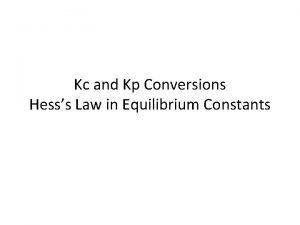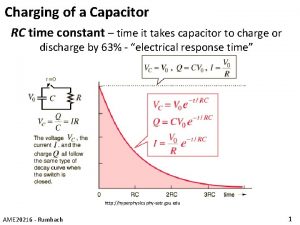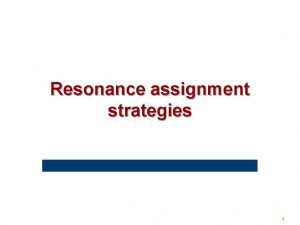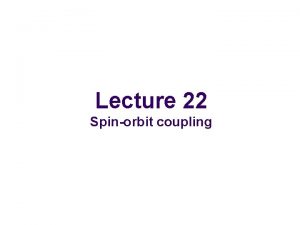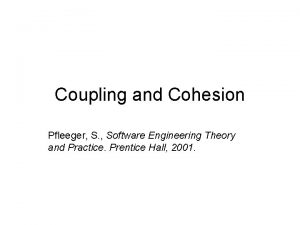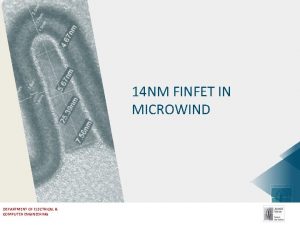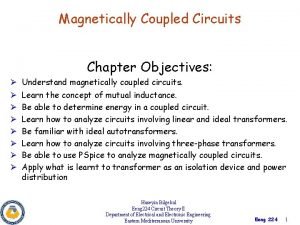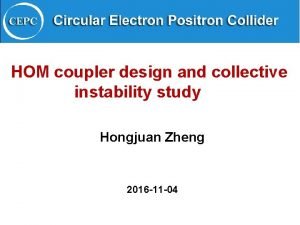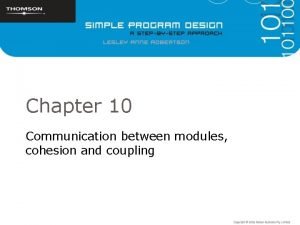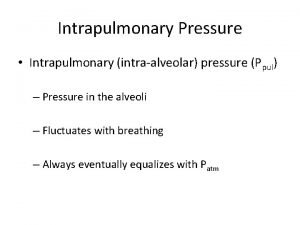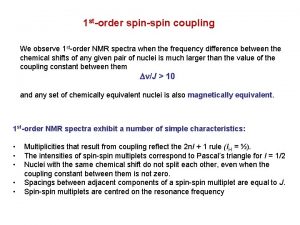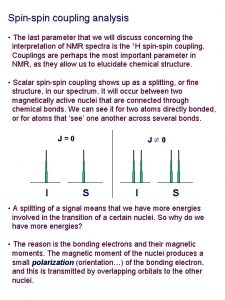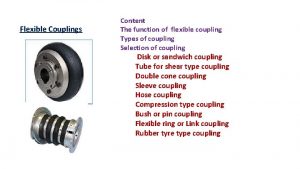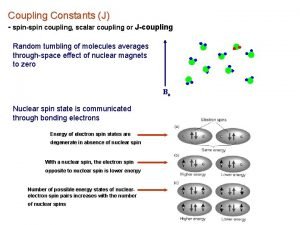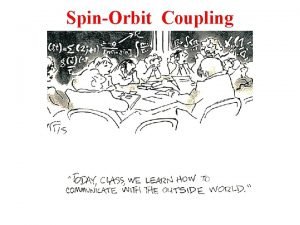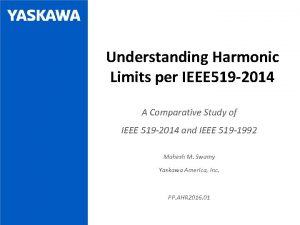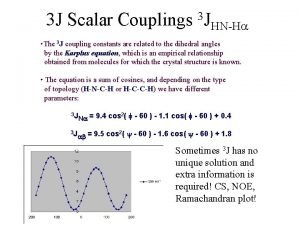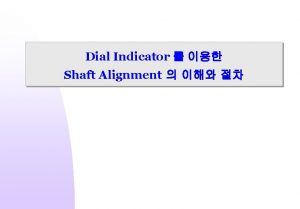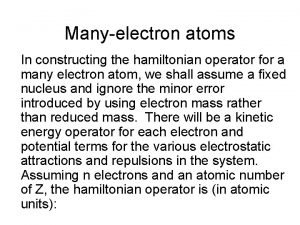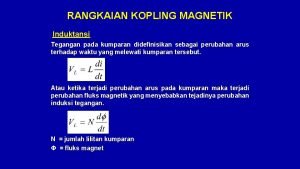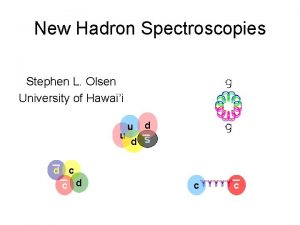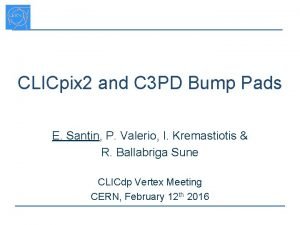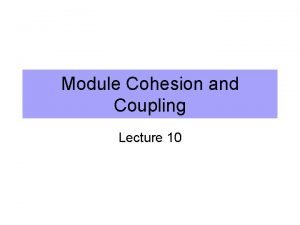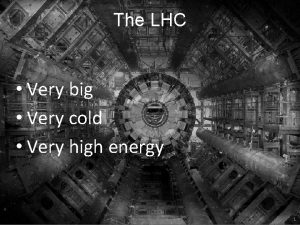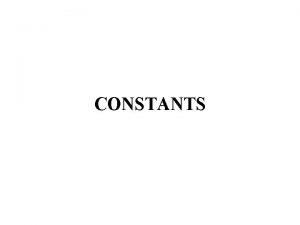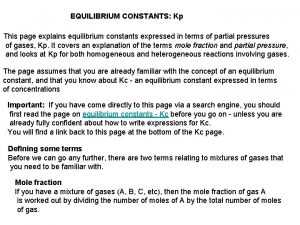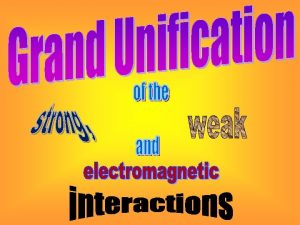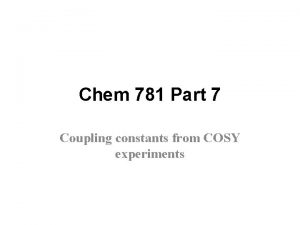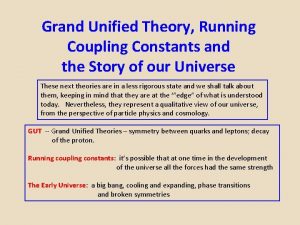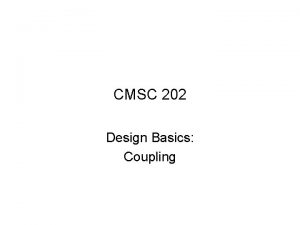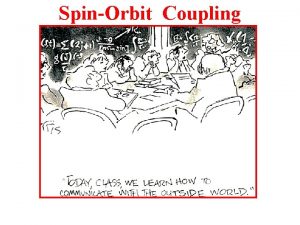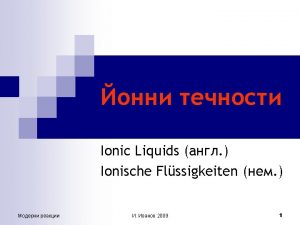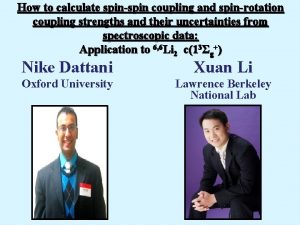Coupling Constants J Coupling constants are a very








































































- Slides: 72

Coupling Constants (J) • • Coupling constants are a very important and useful feature of an NMR spectrum Importantly, coupling constants identifies pairs of nuclei that are chemically bonded to each other 1 • • H 1 H Multiplicity identifies the number of protons (or other nuclei) that are chemical bonded to the other nuclei The magnitude of the coupling constants identifies the coupling partner, and provides information on dihedral angles, hydrogen bonds, the number of intervening bonds, and the type of coupled nuclei (1 H, 13 C, 15 N, 19 F, etc. )

Coupling Constants (J) - spin-spin coupling, scalar coupling or J-coupling Random tumbling of molecules averages through-space effect of nuclear magnets to zero Bo b b ab 2 ab 1 Bo a a random tumbling leads to no interaction between the spin-states despite the small magnetic fields

Coupling Constants (J) - spin-spin coupling, scalar coupling or J-coupling Instead, nuclear spin state is communicated through bonding electrons Energy of electron spin states are degenerate in absence of nuclear spin With a nuclear spin, the electron spin opposite to nuclear spin is lower energy Number of possible energy states of nuclearelectron spin pairs increases with the number of nuclear spins Spin state is “sensed” through bonds resulting in higher or lower energy - aligned or anti-aligned with magnetic field

Coupling Constants Energy level of a nuclei are affected by covalently-bonded neighbors spin-states Mixing of Spin Systems One and Two bb b ab ab ba a a aa Spin System One Spin System Two

Coupling Constants Mixing of energy levels results in additional transitions – peaks are split +J/4 I bb S -J/4 ab J (Hz) I S ba S +J/4 I aa Spin-States of covalently-bonded nuclei want to be aligned The magnitude of the separation is called coupling constant (J) and has units of Hz

Coupling Constants • Through-bond interaction that results in the splitting of a single peak into multiple peaks of various intensities Ø Spacing in hertz (hz) between the peaks is a constant Ø Independent of magnetic field strength Multiple coupling interactions may exist Ø Increase complexity of splitting pattern Coupling can range from one-bond to five-bond Ø One, two and three bond coupling are most common Ø Longer range coupling usually occur through aromatic systems Coupling can be between heteronuclear and homonuclear spin pairs Ø Both nuclei need to be NMR active i. e. 12 C does not cause splitting • • • 1 1 H 13 1 H H three-bond C four-bond one-bond 1 1 H five-bond H

Coupling Constants • Splitting pattern depends on the number of equivalent atoms bonded to the nuclei Ø Ø Determines the number of possible spin-pair combinations and energy levels Each peak intensity in the splitting pattern is determined by the number of spin pairs of equivalent energy

Coupling Constants • Splitting pattern follows Pascal’s triangle Ø Number of peaks and relative peak intensity determined by the number of attached nuclei Ø Peak separation determined by coupling constant (J) Ø Negative coupling reverse relative energy levels 1 1 2 1 1 3 3 1 1 4 6 41 1 5 10 10 5 1 1 6 15 20 15 6 1 1 7 21 35 35 21 7 1 Pascal’s triangle 3 3 3 attached nuclei 1 J J J Quartet 1 Relative Intensity

Coupling Constants Common NMR Splitting Patterns singlet doublet 1: 1 triplet quartet 1: 2: 1 1: 3: 3: 1 pentet 1: 4: 6: 4: 1 Coupling Rules: 1. 2. 3. 4. 5. 6. 7. equivalent nuclei do not interact coupling constants decreases with separation ( typically # 3 bonds) multiplicity given by number of attached equivalent protons (n+1) multiple spin systems multiplicity (na+1)(nb+1) Relative peak heights/area follows Pascal’s triangle Coupling constant are independent of applied field strength Coupling constants can be negative IMPORTANT: Coupling constant pattern allow for the identification of bonded nuclei.

Coupling Constants Common NMR Splitting Patterns

Coupling Constants • Coupling only occurs between non-equivalent nuclei Ø Chemical shift equivalence Ø Magnetic equivalence Ø For no coupling to occur, nuclei has to be BOTH chemical shift and magnetic equivalent The CH 3 protons (H 1, H 2, H 3) are in identical environments, are equivalent, and are not coupled to one another The Ha and Hb protons are in different environments (proximity to Cl), are not equivalent, and are coupled

Coupling Constants Rules for Chemical Shift Equivalence: • Nuclei are interchangeable by symmetry operation i. Rotation about symmetric axis (Cn) ii. Inversion at a center of symmetry (i) iii. reflection at a plane of symmetry (s) iv. Higher orders of rotation about an axis followed by reflection in a plane normal to this axis (Sn) v. Symmetry element (axis, center or plane) must be symmetry element for entire molecule Examples of Chemical Shift Equivalent Nuclei 180 o Symmetry planes

Coupling Constants Rules for Chemical Shift Equivalence: • Nuclei are interchangeable by a rapid process i. > once in about 10 -3 seconds ii. Rotation about a bond, interconversion of ring pucker, etc. Examples of Chemical Shift Equivalent Nuclei Rapid exchange

Coupling Constants Magnetic Equivalence: • Nuclei must first be chemical shift equivalent • Must couple equally to each nucleus in every other set of chemically equivalent nuclei i. need to examine geometrical relationships ii. the bond distance and angles from each nucleus to another chemical set must be identical iii. Nuclei can be interchanged through a reflection plane passing through the nuclei from the other chemical set and a perpendicular to a line joining the chemical shift equivalent nuclei Examples of Non-magnetically equivalent nuclei Chemical shift equivalent, but not magnetic equivalent 3 J ≠ 3 J ab a’b 3 J 3 ab’ ≠ Ja’b’ 3 J 3 Ha. Fa ≠ JHa’Fa 3 J 3 Ha. Fa’ ≠ JHa’Fa’ 3 J 3 Ha. Hc ≠ JHa. Hc’ 3 J 3 Hb. Hc ≠ JHb. Hc’ 3 J 3 Ha. Hc ≠ JHb. Hc 3 J 3 Ha. Hc’ ≠ JHb. Hc’

Coupling Constants Magnetic Equivalence: • Non-magnetically equivalent nuclei may lead to second order effects and very complex splitting patterns • Second order effects will be discussed later i. Due to small chemical shift differences between coupled nuclei (Dn ~ J) http: //www. chem. wisc. edu/areas/reich/chem 605/index. htm

Coupling Constants Multiple Spin Systems multiplicity (na+1)(nb+1) 3 J = 6 Hz Hb What is the splitting pattern for CH 2? 3 J = 7 Hz Ha 3 J Hb = 6 Hz 1 11 121 1331 14641 1 5 10 10 5 1 1 6 15 20 15 6 1 1 7 21 35 35 21 7 1 Coupling to Hb splits the CH 2 resonance into a doublet separated by 6 Hz Down-field resonance split into quartet up-field resonance split into quartet Coupling to Ha splits each doublet into a quartet separated by 7 Hz

Coupling Constants What Happens to Splitting Pattern if J changes? 3 J = 7 Hz Hb 3 J = 7 Hz Ha Looks like a pentet! Intensities don’t follow Pascal’s triangle (1 4 6 4 1) 3 J = 6 Hz Hb 3 J = 3 Hz Ha Looks like a sextet! Intensities don’t follow Pascal’s triangle (1 5 10 10 5 1) Occurs because of overlap of peaks within the splitting pattern

Coupling Constants Provide Connectivity Information – chemical shifts identify what functional groups are present NMR Peaks for coupled nuclei share the same coupling constants CH 3 CH CH 2 7 Hz 6 Hz Integral: 6 Hz 1 7 Hz 6 Hz 2 7 Hz 3

Coupling Constants Deconvoluting a spin system – determining the J-values – determining the multiplicities present J coupling analysis: i. Is the pattern symmetric about the center? ii. Assign integral intensity to each line, outer lines assigned to 1 iii. Are the intensities symmetric about the center? iv. Add up the assigned intensities – Sum must be 2 n, n = number of nuclei – Ex: sum = 16, n = 4 v. Separation of outer most lines is a coupling constant – Relative intensity determines the number of coupled nuclei – Ex: intensity ratio: 1: 2, 2 coupled nuclei – 1 st splitting pattern is a triplet (1: 2: 1) vi. Draw the first coupling pattern vii. Account for all the peaks in the spin pattern by repeatedly matching the 1 st splitting pattern viii. Smallest coupling constant has been assigned

Coupling Constants Deconvoluting a spin system – determining the J-values – determining the multiplicities present J coupling analysis: ix. Coupling pattern is reduced to the center lines of the 1 st splitting pattern. x. Repeat process – Ex: sum = 8, n = 3 – Ex: intensity ratio: 1: 1, 1 coupled nuclei – 2 nd splitting pattern is a doublet (1: 1) xi. Repeat until singlet is generated

Coupling Constants Demo ACD C+H NMR Viewer software – first order coupling constants

Coupling Constants Description of Spin System – each unique set of spins is assigned a letter from the alphabet Ø the total number of nuclei in the set are indicated as a subscript – the relative chemical shift difference is represented by separation in the alphabet sequence Ø Large chemical shift differences are represented by AX or AMX (n. AX >> JAX) Ø Small chemical shift differences are represented by AB (n. AB < 5 JAB) Ø Can also have mixed systems: ABX magnetically in-equivalent nuclei are differentiated by a single quote: AA’XX’ or brackets [AX]2 Ø [AX]2 or AA’XX’ system CH 2 Cl. CHCl 2 CH 3 CH 2 R CH 3 CH 2 F A 2 X system A 3 X 2 system A 2 M 2 X system AB system

A M A A J(AM) J(AX) J(AM) M X TMS M X J(MX) J(AM) X J(AX) J(AM) = 4 Hz J(AX) = 2. 5 Hz J(MX) = 6 Hz

Coupling Constants (J) Observed splitting is a result of this electron-nucleus hyperfine interaction • Coupling is measured in hertz (Hz) Ø Ø Range from 0. 05 Hz to thousands of Hz Can be positive or negative 1 J C-H and many other one-bond coupling are positive 1 J A-X is negative if g are opposite sign 2 J 3 H-H in sp CH 2 groups are commonly negative 3 J H-H is always positive o o reversed For an AX system, JAX is negative if the energy of the A state is lower when X has the same spin as A (aa or bb) The spin states and transitions are swapped

Coupling Constants (J) Measure the Relative Sign of Coupling Constants • Multiple experimental approaches (different NMR pulse sequences) or simulations E. COSY – two-dimensional NMR experiment cross peaks identify which chemical shifts are coupled

Coupling Constants (J) Measure the Relative Sign of Coupling Constants • The cross-peak patterns identifies the coupling constant sign and magnitude Based on the slopes of the diagonal line drawn through coupling pattern 3 J and 3 J have the same sign AX BX 3 J opposite sign of 3 J and 3 J AB AX BX Yellow-highlighted regions are expanded

Coupling Constants (J) • Magnitude of the splitting is dependent on: Ø Number of bonds 3 J 9. 4 Hz AB 4 J 1. 1 Hz AC 5 J 0. 9 Hz AB Ø Bond order (single, double triple) 3 J 8 Hz HH Ø 3 J 11. 6 & 19. 1 Hz HH 3 J 9. 1 Hz HH Angles between bonds trans 3 JHH ~ 17 Hz cis 3 JHH ~10 Hz geminal 2 JHH ~2. 5 Hz

Coupling Constants (J) • Magnitude of the splitting is dependent on: Ø dihedral angle − Fixed or average conformation

Coupling Constants (J) • Magnitude of the splitting is dependent on: Cyclohexanes dihedral angles Ø Fixed or average conformation − 3 J 3 J 9 -12 Hz ee or ea 3 -4 Hz 3 J aa >> 3 J ee, 3 J ea Dual Karplus curves for the axial and equatorial protons

Coupling Constants (J) • Magnitude of the splitting is dependent on: Ø Cyclohexanes dihedral angles − examples

Coupling Constants (J) • Magnitude of the splitting is dependent on: Ø Cyclopentanes dihedral angles − Fixed or average conformation

Coupling Constants (J) • Magnitude of the splitting is dependent on: Ø Comparison between Cyclohexanes and Cyclopentanes In chair cyclohexane, only one vicinal coupling can be large (>7 Hz) Ø Ø In cyclopentane, two or three vicinal coupling can be large (>7 Hz) Because of range of cyclopentane conformations, vicinal couplings are variable: Jcis > Jtrans and Jcis > Jtrans Only in rigid cyclopentanes can a stereochemistry be defined: Jcis > Jtrans

Coupling Constants (J) • Magnitude of the splitting is dependent on: Ø Cyclobutanes are flatter than cyclopentanes, so: Jcis > Jtrans − Ø unless structure features induce strong puckering of the ring or electronegative substituents are present Cyclopropanes are rigidly fixed, so Jcis > Jtrans is always true

Coupling Constants (J) • Magnitude of the splitting is dependent on: Ø Orientation − unless structure features induce strong puckering of the ring or electronegative substituents are present Since methyl groups can freely rotate, the observed coupling is the average of the three individual coupling constants − Internal hydrogen bonds may lead to constrained conformations and distinct different coupling constants

Coupling Constants (J) Magnitude of the splitting is dependent on: Ø 3 J 3 J Electronegativity of Substituents coupling constant decreases as electronegativity increases H-H decreases even more with two electronegative substituents H-H

Coupling Constants (J) Magnitude of the splitting is dependent on: Ø 3 J Electronegativity of Substituents coupling constant decreases as electronegativity of substituents increases for cycloalkenes H-H 3 J coupling constant decreases as electronegativity of substituents increases for alkenes H-H

Coupling Constants (J) Magnitude of the splitting is dependent on: Ø Ring Size − Coupling constants decrease as ring size gets smaller − Coupling constants also decrease as ring is formed and gets smaller

Coupling Constants (J) Magnitude of the splitting is dependent on: Ø Bond order − Coupling constant decreases as bond order decreases 3 J Ø H-H = 8. 65 x (n bond order) + 1. 66 Heterocycles – Heterocycles have smaller coupling constants compared to hydrocarbons systems

Coupling Constants (J) • Magnitude of the splitting is dependent on: Ø Proportional to gagb 1 J C-H 125 Hz 1 J N-H 95 Hz Ø s character of bonding orbital – Increases with increasing s-character in C-H bond 2 J F-H 48. 2 Hz

Coupling Constants (J) • Magnitude of the splitting is dependent on: Ø Attenuated as the number of bonds increase – Usually requires conjugated systems (aromatic, allylic, propargylic, allenic) or favorable geometric alignment (W-coupling) – Not usually seen over more than 4 to 5 bonds (acetylenes and allenes)

Coupling Constants (J) Magnitude of the splitting is dependent on: Ø Geminal protons (H-C-H) fall into two major groups – Unstrained sp 3 CH 2 protons: 2 JH-H -12 Hz – Vinyl sp 2 CH protons: 2 JH-H 2 Hz

Coupling Constants (J) Magnitude of the splitting is dependent on: Ø Geminal protons coupling constants are effected by the electronic effects of substituents – Note: opposite trend Based on the interaction between the filled and empty orbitals of the CH 2 fragment

Coupling Constants (J) Magnitude of the splitting is dependent on electronic effects: Ø Ø In acyclic and unstrained ring systems: 2 JH-H ~ -10 to -13 Hz When CH 2 is substituted with a p-acceptor, like carbonyl or cyano coupling becomes more negative: 2 JH-H ~ -16 to -25 Hz − Ø Reliable and can help with structure assignments Conjugated aryl, alkene and alkyne substituents also makes coupling becomes more negative

Coupling Constants (J) Magnitude of the splitting is dependent on electronic effects: Ø Ø In unsaturated carbons: 2 JH-H ~ 2. 5 Hz Electronegative substituents (F, O) behave as p-acceptors with a negative effect with 2 JH-H close to zero Electropositive substituents (Si, Li) behave as p-donors with a negative effect with 2 JH-H Oxygen substituents can behave as a strong s-acceptor and strong p-donor (lone pair), both positive effects leading to a large 2 JH-H or as a strong pacceptor leading to large negative coupling

Coupling Constants (J) Magnitude of the splitting is dependent on electronic effects: Ø Summary of effects, s and p acceptors have opposite effects on coupling, as do s and p donors

Coupling Constants (J)

Coupling Constants (J)

Coupling Constants (J)

Coupling Constants Weak coupling or first-order approximation • Up to now, we have assumed the frequency difference (chemical shift) between the coupled nuclei is large i. • Dn >> J Second order effects come into play when this assumption is no longer valid i. Dn < 5 J • Second order effects lead to very complex splitting patterns that are difficult, if not impossible to interpret manually and leads to incorrect chemical shifts and coupling constants • Interpreting NMR spectra with second-order effects usually requires software

Coupling Constants (J) Second-Order Effects (Strong Coupling) – occurs when chemical shift differences is similar in magnitude to coupling constants (Dn/J < 5) Ø chemical shifts and coupling constants have similar energy and intermingle Ø results from mixing of the equivalent ab and ba spin states none of the transitions are purely one nuclei described by quantum mechanical wave functions AB spin system

Coupling Constants (J) Second-Order Effects (Strong Coupling) Ø perturbs peak intensity and position AB spin system as chemical shift differences decrease, intensity of outer lines become weaker and internal lines become stronger the multiplet leans towards each other (“roof” effect) which increases as chemical shift difference decreases

Coupling Constants (J) Second-Order Effects (Strong Coupling) Ø becomes easier to interpret at higher magnetic field strengths Higher field increases Dn/J

Coupling Constants (J) Second-Order Effects (Strong Coupling) – hierarchy of coupling constants with increasing second-order effects 1. AX and all other first order systems (AX 2, AMX, A 3 X 2, etc. ) 2. AB i. Line intensities start to lean ii. J can be measured, d can be calculated 3. AB 2 i. Extra lines ii. Both J and d have to be calculated 4. ABX, ABX 2, ABX 3 i. JAB can be measured, everything else requires calculation 5. ABC i. Both J and d have to be determined from computer simulation 6. AA’XX’ i. Do not become first order even at high magnetic fields ii. Both J and d have to be determined from computer simulation 7. AA’BB’ 8. AA’BB’X 9. Etc.

Coupling Constants (J) Second-Order Effects (Strong Coupling) – general effect of strong couplings on NMR spectra 1. Line intensities are no longer integral ratios, no longer follow Pascal’s triangle 2. Line positions are no longer symmetrically related to chemical shift position i. 3. Multiplet center may no longer be chemical shift (AB and higher) Some or all coupling constants can no longer be obtained from the line separations (ABX and higher) 4. The signs of coupling constants affect the line positions and intensities (ABX and higher) 5. Additional lines over the number predicted by simple coupling rules appear i. Peaks with intensities of 2 or more are split into individual components More lines then the expected triplet for the boxed CH 2 pair

Coupling Constants (J) Second-Order Effects (Strong Coupling) – general effect of strong couplings on NMR spectra 6. Coupling between equivalent nuclei (JAA’ or JXX’) affects line count and position 7. i. Second order effects appear even if Dn/J is large for groups of magnetically non -equivalent protons with identical chemical shifts which are coupled i. Do not get simpler at higher fields Computer analysis becomes mandatory to extract accurate J and d values (ABC and higher) 8. Ultimately spectra become so complex that the only useful information is integration, chemical shift and general appearance.

Coupling Constants (J) Second-Order Effects – as the chemical shifts coalesce Ø intensity of outer lines decrease inner peaks eventually collapse to singlet Ø nuclei become chemically and magnetically equivalent Ø Weaker outer lines may be overlooked and interpreted as a doublet May be misinterpreted as a quartet AB spin system

Coupling Constants (J) Second-Order Effects (AB) – analysis of second-order splitting patterns Ø remember: resonance positions are also perturbed Ø separation between outer lines and inner lines (a-b, c-d) yields coupling constant Ø JAB = (na-nb) = (nc-nd) true chemical shift is not the doublet centers ncenter = ½(nb+nc) Dn. AB = √ (na-nd) (nb-nc) n. A = ncenter + ½ Dn. AB n. B = ncenter - ½ Dn. AB d. A d. B

Coupling Constants (J)

Coupling Constants (J) Second-Order Effects (AB 2) – as the chemical shifts coalesce Ø line intensities no longer follow simple rules arithmetic average of the line positions no longer give true chemical shifts Ø JAB can still be measured directly from spectrum Ø Ø none of the line separation correspond to JAB Ø additional lines appear AB 2 spin system Note: splitting of intense lines

Coupling Constants (J) Second-Order Effects (AB 2) – four A lines n 1 – n 4 and four B lines n 5 – n 8 and the very weak combination line n 9 – calculation of n. A, n. B, and JAB is simple: – how to report an AB 2 spin system in a journal manuscript: report the two chemical shifts as an AB 2 multiplete (m): 2. 63, 2. 69 (AB 2 m, 3 H, JAB = 12. 2 Hz)

Coupling Constants (J) Second-Order Effects (AB 2) – unique features of second-order splitting pattern for AB 2 system Ø Spectrum depends only on the ratio Dn/J Ø lines 1 to 4 correspond to the one proton part (A) Ø lines 5 to 8 correspond to the two-proton part (B 2) Ø line 5 (n 5) is the most intense line Ø lines 5 and 6 often do not split up Ø when Dn/J << 1, the spectrum appears nearly symmetrical Ø lines 1, 2, 8 (n 1, n 2 , n 8) become very weak looks like a distorted triplet with 1: 10: 1 area ratio JAB and JBB do not affect the spectrum

Coupling Constants (J) Second-Order Effects (ABX) – most complex spin-system that can still be manually analyzed – ABX has a common appearance Ø AB – unsymmetrical 8 -line pattern that integrates to 2 protons Ø AB – 4 doublets with the same separation JAB with strong leaning Ø X – symmetric 6 -line pattern that integrates to 1 proton Ø X – 5 th and 6 th lines are small and not often seen, apparent doublet of doublet Ø JAB and n. X are directly measurable from spectrum n. X - center AB Ø JAX, JBX, n. A and n. B need to be calculated X of peaks

Coupling Constants (J) Second-Order Effects (ABX) – Many ABX patterns are sufficiently close to AMX (n. AB >> JAB) Ø first-order solution has an excellent chance of being correct A & B doublet of doublet separation is JAX & JBX Center doublets and get AB pattern – First, identify the distorted doublet of doublets for both A and B – Remove the splitting (identify the center of each doublet), which leaves an AB pattern – Solve AB pattern as before to get JAB, n. A, and n. B Ø large errors when JAX and JBX are very different or n. AB small compared to JAB

Coupling Constants (J) Second-Order Effects (ABX) – Correct analysis of ABX patterns Ø Reverse the order of extracting coupling constants to approximate solution Identify the two AB quartets Jab+ = Jab- – First, identify the two AB quartets Ø separation between the four pairs of lines are identical Ø tall inner line associated with shorter outer line (leaning)

Coupling Constants (J) Second-Order Effects (ABX) – Correct choice of ab quartet – Incorrect choice of ab quartet

Coupling Constants (J) Second-Order Effects (ABX) – Solve the two ab quartets Ø Treat as normal AB patterns and obtain four chemical shifts (na+, nb+, na-, nb-) Ø Don’t know which half is a and which is b - two possible solutions

Coupling Constants (J) Second-Order Effects (ABX) – Solution 1 and Solution 2 – depends on the relative sign of JAX and JBX Ø Solution 1: JAX and JBX same sign Ø Solution 2: JAX and JBX different sign Swap the a & b labels

Coupling Constants (J) Second-Order Effects (ABX) – Which solution is the correct one? – Several criteria can be used: 1. Magnitude of the couplings – one solution may give dubious (very large or very small) couplings 2. Signs of coupling constants – the signs can sometimes be predicted and rule out a solution § all vicinal 3 J couplings are positive, § geminal 2 J couplings at sp 3 carbons are usually negative § CHXCHAHB – JAX and JBX have the same sign § CHACHBHX – JAX and JBX have different signs 3. Analysis of the X-part – the intensities of the lines in the X-part are always different – most reliable way to identify the correct solution Two different X patterns depending on relative sign of JAX and JBX

Coupling Constants (J) Second-Order Effects (ABX) – Effective of relative sign of JAX and JBX on AB pattern Solution 1 JAX and JBX same sign Solution 2 JAX and JBX different sign

Coupling Constants (J) Second-Order Effects (ABX) – AB pattern from ABX spin system as a function of changing n. AB

Coupling Constants (J) Second-Order Effects (ABX) – AB pattern from ABX spin system as a function of the relative sign and Magnitude of JAX and JBX same sign JAX and JBX different sign

Coupling Constants (J) Demo ACD C+H NMR Viewer software – second order coupling constants
 Antigentest åre
Antigentest åre Coupling constant
Coupling constant Geminal coupling
Geminal coupling Factors affecting chemical shift
Factors affecting chemical shift Geminal coupling
Geminal coupling Fewfewfewf
Fewfewfewf It is a very shallow skillet with very short sloping sides
It is a very shallow skillet with very short sloping sides Figure 10
Figure 10 Quantifiers for food
Quantifiers for food Multiplication of scientific notation
Multiplication of scientific notation Game maker教學
Game maker教學 Constants c#
Constants c# Constants scientific method
Constants scientific method Crystal binding and elastic constants
Crystal binding and elastic constants Avogadro's law constants
Avogadro's law constants Unit of r
Unit of r Crystals for binding
Crystals for binding Constant integer
Constant integer Equilibrium constants
Equilibrium constants Rc time constants
Rc time constants Whats a constant term
Whats a constant term Constants in scientific method
Constants in scientific method Named constants in java
Named constants in java Control chart constants
Control chart constants Definition of le chatelier's principle
Definition of le chatelier's principle Natural logarithm in matlab
Natural logarithm in matlab Elastic compliance and stiffness constants
Elastic compliance and stiffness constants Static error constants
Static error constants Hess law for equilibrium constants
Hess law for equilibrium constants Is time constant
Is time constant Energy flow in biological systems
Energy flow in biological systems What is ventilation-perfusion coupling
What is ventilation-perfusion coupling Program data dependence refers to the coupling
Program data dependence refers to the coupling Gauge coupling unification
Gauge coupling unification Atp cycle diagram
Atp cycle diagram J-coupling
J-coupling Low coupling in software engineering
Low coupling in software engineering Software engineering roadmap
Software engineering roadmap Atra flex coupling insert
Atra flex coupling insert L-l coupling
L-l coupling Low coupling in software engineering
Low coupling in software engineering Define coupling in software engineering
Define coupling in software engineering Coupling capacitance
Coupling capacitance Magnetic coupled circuits
Magnetic coupled circuits Design of coupling
Design of coupling Difference between cohesion and coupling
Difference between cohesion and coupling Chafing blocks fire hose
Chafing blocks fire hose Focus figure 9.2: excitation-contraction coupling
Focus figure 9.2: excitation-contraction coupling 9:3:3:1 ratio
9:3:3:1 ratio Ventilation perfusion coupling
Ventilation perfusion coupling Resonant inductive coupling ppt
Resonant inductive coupling ppt Retirement stage of family life cycle
Retirement stage of family life cycle Design of coupling
Design of coupling Optical coupling in fluoroscopy
Optical coupling in fluoroscopy Enantiotopic protons
Enantiotopic protons Spin spin coupling
Spin spin coupling Function of flexible coupling
Function of flexible coupling Spin spin coupling
Spin spin coupling Safety breakaway coupling
Safety breakaway coupling Spin orbit coupling
Spin orbit coupling Linkage phase
Linkage phase Ieee 519 1992
Ieee 519 1992 3j coupling
3j coupling Alignment coupling dial gauge
Alignment coupling dial gauge Booster hose is designed to be carried:
Booster hose is designed to be carried: What is ls and jj coupling
What is ls and jj coupling Coupling coefficient
Coupling coefficient Engineering drawing assembly
Engineering drawing assembly Parallel spin
Parallel spin Rangkaian kopling magnetik
Rangkaian kopling magnetik Olsen palermo
Olsen palermo Coupling capacitance
Coupling capacitance Sequential cohesion
Sequential cohesion

